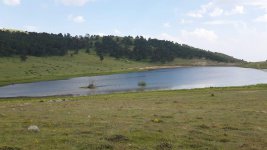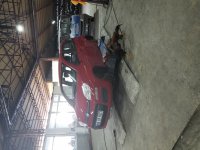So, I've finally gotten around to moving on from the (arguably fantastic) CrossContact Winter tyres on Mario, and have a fresh set of WinterContact TS860s on it. I apologize up front for the lack of photos, as thinking they were backed up to the cloud (I use Google Photos), I deleted the off-roading adventures of yesterday while I was still out of cell range and have lost them forever. Now I'll have an excuse to go back out some time.
Here's the TL;DR: The TS860s are an excellent winter road tyre with higher performance on every road surface than the old CrossContact Winters, and while the limits of acceleration, braking and lateral grip have gone up, this also means that when it does run out of friction it does so more abruptly. Off road, the old CrossContacts were better in both mud and deep snow, but considering I spend 95% of the time on the road it's an acceptable tradeoff.
Here's the long story (jump down 2 paragraphs to get to the actual review and skip the back story): I've very much enjoyed the Conti CrossContacts that came on the 4x4. As you may know, they were originally labelled an all season A/T tyre despite being called 'CrossContact Winter', so they had big blocky tread, plenty of sipes, and reinforced sidewalls. I liked them so much, once my original set was worn down I went out of my way to find another set. Since they were no longer being sold where I lived, I had to settle for an old set of tyres that were just newer than what I already had. As such, I used that set down quite quickly and now I simply can't find the old CrossContacts at all. Sure, there was one online seller selling them 'new', but they were manufactured in 2014 making them already 4 years old and not knowing how they were stored, susceptible to dry rot, flat spots and weakened sidewalls.
Since I wanted a replacement that would do everything I asked of the CrossContacts, I started out looking for A/T tyres. I was even willing to forgo 'winter' tyres for a summer with the M+S designation (which, I know, technically means nothing really) and had decided on the Michelin Latitude Cross. The Latitude is a very old design, but many 'weekend warrior' offroaders still swear by them as the tread pattern gives them excellent grip on gravel/dirt and mud, with acceptable performance in snow and on asphalt. They are, however, very hard to find in a size that will fit the Panda and the only place that had them in that size wanted an exorbitant amount of money which I couldn't justify, as it would cost me just as much to get dedicated winter and summer sets. Eventually, I had to give up on my A/T tyre ambitions as they simply aren't available in appropriate sizes where I live.
Thus, I moved on to researching a set of winters that would get me to the top of my favorite ski resort. Sure, Nokian are the winter experts but the dry performance leaves something to be desired. Michelin Alpin are great on ice and snow but their prices are more than I would want to pay for. The TS860 has been getting consistently good reviews in all tyre tests though, and even occasionally outperforming all season tyres in dry and wet tests (tyrereviews even recommended them as a possible all season). Armed with the ambition of the possibility of using them year round like the CrossContacts, I bit the bullet and got a set of four.
The first 200 kilometers on the TS860 were spent breaking them in. Mostly in town, occasional highway stints, then returned to the Conti dealer for a re-balance. Since then, I've done about 650km on them for a total just shy of 1000km. They were, indeed, a little odd during break in. The levels of grip increased during that period and the sidewall stiffness reduced significantly. Now here are my findings divided into categories:
Dry: When I purchased the tyres it was still about 14-15C outside and mostly dry. The initial 'bite' of the 860s, along with the V shaped tread pattern give them a contact patch with more longitudinal friction points than the CrossContacts so initial grip is much higher. Lateral grip, however, seems to be about the same despite having a more aggressive, road-biased tread pattern. The dead-center performance is better, with initial turn in being slightly sharper, but the actual lateral grip in the dry (the amount of speed I can carry through a certain bend without any slipping) is only slightly higher. What has improved greatly, however, is the feedback from the tyres. I can tell where the limits of grip are much more accurately through the steering wheel and the highly calibrated bum g-meter, so it feels much more sure-footed and lets me know when it's approaching the limit (the front end gives out first, while the CrossContacts had a tendency to lose grip equally between the front and rear). Braking, as expected, is much improved. So much so, that I think I will be needing new front pads quite soon. Tracking during braking is also improved, so less steering correction is required under heavy braking to keep everything straight.
Wet: The wet is where I had a love/hate relationship with my CrossContacts. Their wet performance was very average, with hard acceleration engaging traction control and the rear wheels on occasion, and relatively poor aquaplaning (I really needed to be careful going through puddles at speed). The tradeoff was that the lateral grip in the wet was low, but so progressive it was actually a fun drive. The whole 'slow car fast is more fun than fast car slow' mantra really applied to wet performance. I'd take turns slower, but could control the rotation of the vehicle with a trailing throttle. The TS860 are a different story. Initial turn in in the wet is slightly sharper than before, but the level of lateral grip is much higher. Even very aggressive throttle or brake inputs hardly influence the stability of the car, but... During very tight corners adjusting the vehicle rotation with a trailing throttle is less progressive. It grips and grips and grips until it doesn't, and it's the front end that gives out suddenly. This is especially apparent in decreasing radius turns where the car settles into the bend, and as I increase steering input either off throttle or while feathering it, it loads up well until the front says 'nope' and gives out. This isn't accompanied by the typical lightening of the steering wheel as the steering load also increases progressively. When it does give out, the load is still there but you just see the inside of the corner parting ways with you. Essentially, the limit of grip is higher but the loss of grip is more abrupt and less progressive with less indication of what the front end is doing. Wet braking and aquaplaning, however, are both significantly improved over the CrossContacts. Less ABS intervention, less wandering, and less tugging at the wheel when going through water patches at speed.
Snow: The coup de grace of the TS860 is snow performance, with two caveats. The first is that snow performance is similar to wet performance: overall excellent with improved grip. I even struggled to get traction control intervention or the 4x4 system to engage with aggressive acceleration with the TS860, while I could get some nice 4x4 launches from the lights with the CrossContacts. That being said, lateral grip is again much improved over them but it's less progressive, and again it's the front end that lets go somewhat abruptly. The second is that the CrossContacts had more bite in deep snow. This isn't much of an issue on road, as even on unplowed roads the TS860 perform admirably, but when the depth gets above 25cm, they seem to glide over the powder rather than bite into it. This is mostly apparent in uphill starts where I get more TC and 4x4 engagement than the CrossContacts, and even more apparent while bouncing around on snowy fields. This, of course, is only relevant information for nutters like me who would actually go into snow deep enough to use the radiator as a snow plow and is not applicable to sane people who rather like having front bumpers.
Off road: The deep snow performance is also indicative of the off road performance in that it doesn't perform as well in deeper mud as the CrossContacts. Sure, these aren't A/T tyres and as such the mud evacuation performance isn't expected to be as good. The block pattern of the CrossContacts allowed for more biting edges, while the V pattern of the 860s makes them more 'floaty' through mud and if you end up losing momentum they start losing bite. The same situation is true for gravel inclines in that they struggle to bite more, and perform better when the surface has ruts and rocks to cling to. Additionally, other than XL models, the TS860 lacks the sidewall reinforcement of the CrossContacts which adds an element of worry regarding possible sidewall failure if a sharp rock is hit at speed, or slid into while grappling with mud. They do, however, have more lateral grip (as with other conditions) than the CrossContacts and navigate tight corners (both uphill and downhill) in slippery conditions with more confidence.
Comfort: At speed, the TS860s have significantly less road noise than the CrossContacts. They also absorb potholes and bumps slightly better. This may be a result of the lack of sidewall reinforcement, which would mean this comfort may end up being a double edged sword in that it may result in damage from a pothole. That being said, the actual tread surface seems to be less forgiving than the CrossContacts and at speed, I can feel the suspension actually damping things like bridge connections and highway expansion joints rather than the tyre flexing through the impact. This, in turn, has settle the ride significantly and made cruising a more pleasurable affair. The downside is that on certain road surfaces, the tread pattern has a tendency to reverberate with a low pitched hiss, but I doubt most people in first world countries would encounter such roads. Another possible downside is that I can hear more of the awful racket of the MultiJet diesel at highway speeds. Basically, on the CrossContacts I could sail along at 65-70mph because the tyre roar would drown out the engine and that was what I was used to. Now, the engine clatters away noticeably enough that I tend to stick to 55-60 in an attempt to have a more comfortable journey. That 15mph average speed difference doesn't really matter point to point as on a 300km trip it would only make a 15-25 minute difference depending on conditions, but added up through 1000km and I will have spent nearly another hour on the road in total. Overall, the tyres have reinforced the need for a 6th gear on the diesel.
Overall: By choosing the TS860s, I've admitted to myself that I spend more time on road than off, and my adventure aspirations of wanting all-terrain performance at the expense of on-road performance have been somewhat suppressed. That being said, the general performance increase on all fronts except off road mean that the TS860 is a better fit for the Panda more often than not. For 4x4 owners, it means a safer, more comfortable trip to get off road in the first place. For regular Panda owners it's a great all rounder with the possibility of year-round use like a four season tyre (albeit with compromises). At the price point, it makes a strong case for getting a set for great winter performance, and seeing how things go when the weather gets warmer. I could see them getting a bit wobbly and losing tread life during, say, a summer trip to the Mediterranean, but I've managed such trips fine with the CrossContacts up to now and think the 860s will be similarly acceptable (as I haven't found a suitable summer tyre for long road trips that end with a drive up a mountain and don't want to spend the exorbitant amount for all seasons that fit the bill but compromise on all fronts).
If I were to score them, 1 point off for sudden understeer in the wet and snow, 1 point off for off-road performance and worry, and we end up at a solid 8/10.
Here's the TL;DR: The TS860s are an excellent winter road tyre with higher performance on every road surface than the old CrossContact Winters, and while the limits of acceleration, braking and lateral grip have gone up, this also means that when it does run out of friction it does so more abruptly. Off road, the old CrossContacts were better in both mud and deep snow, but considering I spend 95% of the time on the road it's an acceptable tradeoff.
Here's the long story (jump down 2 paragraphs to get to the actual review and skip the back story): I've very much enjoyed the Conti CrossContacts that came on the 4x4. As you may know, they were originally labelled an all season A/T tyre despite being called 'CrossContact Winter', so they had big blocky tread, plenty of sipes, and reinforced sidewalls. I liked them so much, once my original set was worn down I went out of my way to find another set. Since they were no longer being sold where I lived, I had to settle for an old set of tyres that were just newer than what I already had. As such, I used that set down quite quickly and now I simply can't find the old CrossContacts at all. Sure, there was one online seller selling them 'new', but they were manufactured in 2014 making them already 4 years old and not knowing how they were stored, susceptible to dry rot, flat spots and weakened sidewalls.
Since I wanted a replacement that would do everything I asked of the CrossContacts, I started out looking for A/T tyres. I was even willing to forgo 'winter' tyres for a summer with the M+S designation (which, I know, technically means nothing really) and had decided on the Michelin Latitude Cross. The Latitude is a very old design, but many 'weekend warrior' offroaders still swear by them as the tread pattern gives them excellent grip on gravel/dirt and mud, with acceptable performance in snow and on asphalt. They are, however, very hard to find in a size that will fit the Panda and the only place that had them in that size wanted an exorbitant amount of money which I couldn't justify, as it would cost me just as much to get dedicated winter and summer sets. Eventually, I had to give up on my A/T tyre ambitions as they simply aren't available in appropriate sizes where I live.
Thus, I moved on to researching a set of winters that would get me to the top of my favorite ski resort. Sure, Nokian are the winter experts but the dry performance leaves something to be desired. Michelin Alpin are great on ice and snow but their prices are more than I would want to pay for. The TS860 has been getting consistently good reviews in all tyre tests though, and even occasionally outperforming all season tyres in dry and wet tests (tyrereviews even recommended them as a possible all season). Armed with the ambition of the possibility of using them year round like the CrossContacts, I bit the bullet and got a set of four.
The first 200 kilometers on the TS860 were spent breaking them in. Mostly in town, occasional highway stints, then returned to the Conti dealer for a re-balance. Since then, I've done about 650km on them for a total just shy of 1000km. They were, indeed, a little odd during break in. The levels of grip increased during that period and the sidewall stiffness reduced significantly. Now here are my findings divided into categories:
Dry: When I purchased the tyres it was still about 14-15C outside and mostly dry. The initial 'bite' of the 860s, along with the V shaped tread pattern give them a contact patch with more longitudinal friction points than the CrossContacts so initial grip is much higher. Lateral grip, however, seems to be about the same despite having a more aggressive, road-biased tread pattern. The dead-center performance is better, with initial turn in being slightly sharper, but the actual lateral grip in the dry (the amount of speed I can carry through a certain bend without any slipping) is only slightly higher. What has improved greatly, however, is the feedback from the tyres. I can tell where the limits of grip are much more accurately through the steering wheel and the highly calibrated bum g-meter, so it feels much more sure-footed and lets me know when it's approaching the limit (the front end gives out first, while the CrossContacts had a tendency to lose grip equally between the front and rear). Braking, as expected, is much improved. So much so, that I think I will be needing new front pads quite soon. Tracking during braking is also improved, so less steering correction is required under heavy braking to keep everything straight.
Wet: The wet is where I had a love/hate relationship with my CrossContacts. Their wet performance was very average, with hard acceleration engaging traction control and the rear wheels on occasion, and relatively poor aquaplaning (I really needed to be careful going through puddles at speed). The tradeoff was that the lateral grip in the wet was low, but so progressive it was actually a fun drive. The whole 'slow car fast is more fun than fast car slow' mantra really applied to wet performance. I'd take turns slower, but could control the rotation of the vehicle with a trailing throttle. The TS860 are a different story. Initial turn in in the wet is slightly sharper than before, but the level of lateral grip is much higher. Even very aggressive throttle or brake inputs hardly influence the stability of the car, but... During very tight corners adjusting the vehicle rotation with a trailing throttle is less progressive. It grips and grips and grips until it doesn't, and it's the front end that gives out suddenly. This is especially apparent in decreasing radius turns where the car settles into the bend, and as I increase steering input either off throttle or while feathering it, it loads up well until the front says 'nope' and gives out. This isn't accompanied by the typical lightening of the steering wheel as the steering load also increases progressively. When it does give out, the load is still there but you just see the inside of the corner parting ways with you. Essentially, the limit of grip is higher but the loss of grip is more abrupt and less progressive with less indication of what the front end is doing. Wet braking and aquaplaning, however, are both significantly improved over the CrossContacts. Less ABS intervention, less wandering, and less tugging at the wheel when going through water patches at speed.
Snow: The coup de grace of the TS860 is snow performance, with two caveats. The first is that snow performance is similar to wet performance: overall excellent with improved grip. I even struggled to get traction control intervention or the 4x4 system to engage with aggressive acceleration with the TS860, while I could get some nice 4x4 launches from the lights with the CrossContacts. That being said, lateral grip is again much improved over them but it's less progressive, and again it's the front end that lets go somewhat abruptly. The second is that the CrossContacts had more bite in deep snow. This isn't much of an issue on road, as even on unplowed roads the TS860 perform admirably, but when the depth gets above 25cm, they seem to glide over the powder rather than bite into it. This is mostly apparent in uphill starts where I get more TC and 4x4 engagement than the CrossContacts, and even more apparent while bouncing around on snowy fields. This, of course, is only relevant information for nutters like me who would actually go into snow deep enough to use the radiator as a snow plow and is not applicable to sane people who rather like having front bumpers.
Off road: The deep snow performance is also indicative of the off road performance in that it doesn't perform as well in deeper mud as the CrossContacts. Sure, these aren't A/T tyres and as such the mud evacuation performance isn't expected to be as good. The block pattern of the CrossContacts allowed for more biting edges, while the V pattern of the 860s makes them more 'floaty' through mud and if you end up losing momentum they start losing bite. The same situation is true for gravel inclines in that they struggle to bite more, and perform better when the surface has ruts and rocks to cling to. Additionally, other than XL models, the TS860 lacks the sidewall reinforcement of the CrossContacts which adds an element of worry regarding possible sidewall failure if a sharp rock is hit at speed, or slid into while grappling with mud. They do, however, have more lateral grip (as with other conditions) than the CrossContacts and navigate tight corners (both uphill and downhill) in slippery conditions with more confidence.
Comfort: At speed, the TS860s have significantly less road noise than the CrossContacts. They also absorb potholes and bumps slightly better. This may be a result of the lack of sidewall reinforcement, which would mean this comfort may end up being a double edged sword in that it may result in damage from a pothole. That being said, the actual tread surface seems to be less forgiving than the CrossContacts and at speed, I can feel the suspension actually damping things like bridge connections and highway expansion joints rather than the tyre flexing through the impact. This, in turn, has settle the ride significantly and made cruising a more pleasurable affair. The downside is that on certain road surfaces, the tread pattern has a tendency to reverberate with a low pitched hiss, but I doubt most people in first world countries would encounter such roads. Another possible downside is that I can hear more of the awful racket of the MultiJet diesel at highway speeds. Basically, on the CrossContacts I could sail along at 65-70mph because the tyre roar would drown out the engine and that was what I was used to. Now, the engine clatters away noticeably enough that I tend to stick to 55-60 in an attempt to have a more comfortable journey. That 15mph average speed difference doesn't really matter point to point as on a 300km trip it would only make a 15-25 minute difference depending on conditions, but added up through 1000km and I will have spent nearly another hour on the road in total. Overall, the tyres have reinforced the need for a 6th gear on the diesel.
Overall: By choosing the TS860s, I've admitted to myself that I spend more time on road than off, and my adventure aspirations of wanting all-terrain performance at the expense of on-road performance have been somewhat suppressed. That being said, the general performance increase on all fronts except off road mean that the TS860 is a better fit for the Panda more often than not. For 4x4 owners, it means a safer, more comfortable trip to get off road in the first place. For regular Panda owners it's a great all rounder with the possibility of year-round use like a four season tyre (albeit with compromises). At the price point, it makes a strong case for getting a set for great winter performance, and seeing how things go when the weather gets warmer. I could see them getting a bit wobbly and losing tread life during, say, a summer trip to the Mediterranean, but I've managed such trips fine with the CrossContacts up to now and think the 860s will be similarly acceptable (as I haven't found a suitable summer tyre for long road trips that end with a drive up a mountain and don't want to spend the exorbitant amount for all seasons that fit the bill but compromise on all fronts).
If I were to score them, 1 point off for sudden understeer in the wet and snow, 1 point off for off-road performance and worry, and we end up at a solid 8/10.







